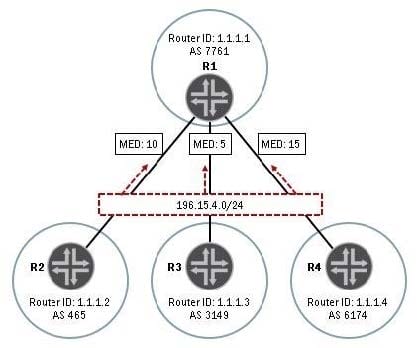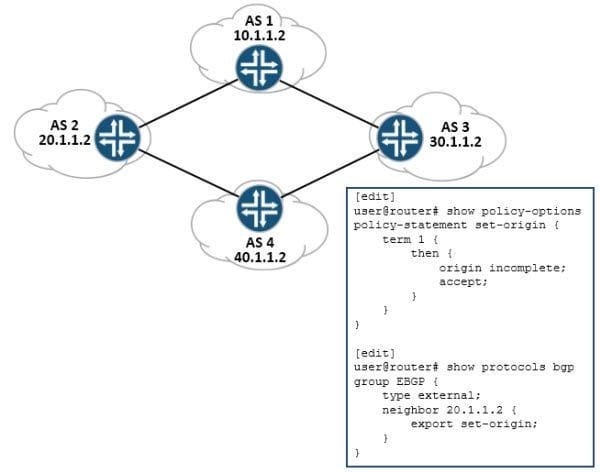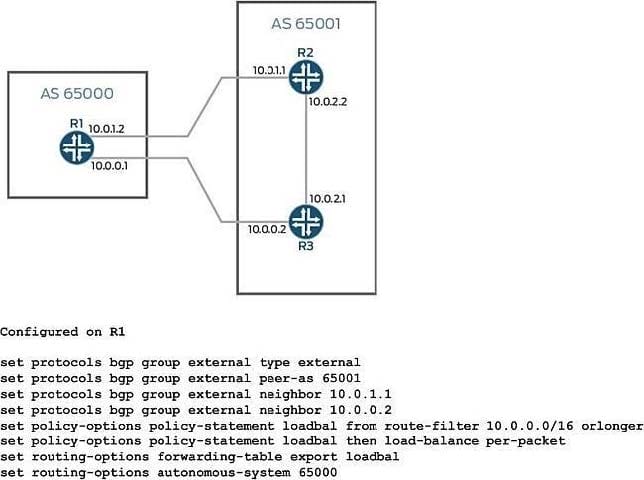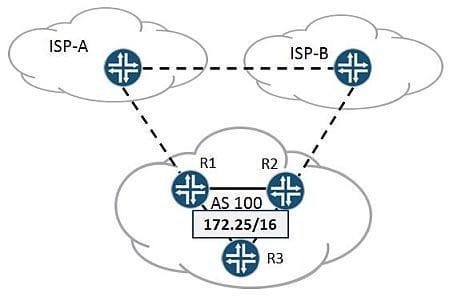Exam Details
Exam Code
:JN0-643Exam Name
:Enterprise Routing and Switching, Professional (JNCIP-ENT)Certification
:Juniper CertificationsVendor
:JuniperTotal Questions
:287 Q&AsLast Updated
:Mar 24, 2025
Juniper Juniper Certifications JN0-643 Questions & Answers
-
Question 241:
Which two statements are true about the configuration shown below? (Choose two.)
[edit routing-options multicast] user@router# show ssm-groups 227.0.0.0/24; asm-override-ssm;
A. It allows SSM operations in only the 227.0.0.0/24 range.
B. It allows SSM operations in the 227.0.0.0/24 range and the dedicated range.
C. It allows only ASM operations in the dedicated SSM range.
D. It allows both ASM and SSM operations in the dedicated SSM range.
-
Question 242:
-- Exhibit

-- Exhibit -Click the Exhibit button.
Referring to the exhibit, the RPT from R3 towards R2 is established.
What happens if the multicast source connected to R1 starts sending multicast traffic towards R1?
A. R1 encapsulates the multicast packets into a PIM register multicast packet.
B. R1 encapsulates the multicast packets into PIM join unicast messages.
C. R1 forwards the multicast packets on the (S,G) tree towards the RP.
D. R1 tunnels the multicast packets in PIM register messages towards the RP.
-
Question 243:
-- Exhibit -user@R1> show pim join extensive InstancE. PIM.master Family: INET R = Rendezvous Point Tree, S = Sparse, W = Wildcard Group: 224.50.50.50 SourcE. * RP: 10.100.100.10 Flags: sparse,rptree,wildcard Upstream interfacE. ge-0/0/10.0 Upstream neighbor: 172.28.55.5 Upstream statE. Join to RP UptimE. 00:00:10 Downstream neighbors: InterfacE. ge-0/0/2.0
172.28.57.5 StatE. Join Flags: SRW Timeout: 209
Group: 224.50.50.50 SourcE. 10.100.10.10 Flags: sparse,spt Upstream interfacE. ge-0/0/6.0 Upstream neighbor: 172.28.56.5 Upstream statE. Join to Source, Prune to RP UptimE. 00:00:10 Keepalive timeout: 276 Downstream neighbors: InterfacE. ge-0/0/2.0
172.18.57.5 StatE. Join Flags: S Timeout: 209 -- Exhibit -
Click the Exhibit button.
Referring to the output shown in the exhibit, which three statements are true about the PIM implementation on R1? (Choose three.)
A. R1 is receiving multicast traffic over the RPT.
B. R1 is receiving multicast traffic over the SPT.
C. Interface ge-0/0/10 provides the shortest path to the source.
D. The multicast stream flows from 10.100.10.10 to 172.18.57.5.
E. Interface ge-0/0/6 provides the shortest path to the source.
-
Question 244:
-- Exhibit

-- Exhibit -
Click the Exhibit button.
You are the administrator for the network shown in the exhibit. R1 receives the 196.15.4.0/24 route from routers R2, R3, and R4. Local preference values have not been modified in this network. You are asked to ensure that R1 prefers the path through AS 3149 for traffic destined to 196.15.4.0/24.
Which two methods will accomplish this task? (Choose two.)
A. Configure a lower local preference on R3.
B. Configure as-path-prepend on R2 and R4.
C. Configure local-as on R3.
D. Configure always-compare-med on R1.
-
Question 245:
-- Exhibit -user@router>show route advertising-protocol bgp 172.16.36.1 inet.0: 31 destinations, 31 routes (31 active, 0 holddown, 0 hidden) Prefix Nexthop MED Lclpref ASpath
*
10.200.17.0/24 Self I
*
10.200.19.0/24 Self I -- Exhibit -
A.
Create a policy that accepts the more specific contributing routes.
B.
Create a route to 10.200.16.0/21 with a next hop of 172.16.36.1 under the [edit routing- options static] hierarchy.
C.
Create a policy that rejects the more specific contributing routes.
D.
Create a policy to accept aggregate routes.
E.
Create a 10.200.16.0/22 route under the [edit routing-options aggregate] hierarchy.
Click the Exhibit button.
Referring to the exhibit, which three actions would summarize these routes to a BGP peer? (Choose three.)
-
Question 246:
-- Exhibit

-- Exhibit -Click the Exhibit button.
AS4 is using the default path to get to AS1. This path is not modified by any of the ASs shown in the exhibit. AS1 wants to influence this path so that traffic from AS4 comes through AS3.
Where do you apply the policy shown in the exhibit?
A. AS1
B. AS2
C. AS3
D. AS4
-
Question 247:
You are asked to create a BGP routing policy that will delete all communities and reject routes with the community 64321:1234.
Which policy will accomplish this task?
A. user@router# show policy-options policy-statement filter-on-community { term remove-AS65001 { from community AS65001-community; then { community delete AS65001-community; } } term nothing-with-1234 { from community AS64321-community; then reject; } } community AS64321-community members 64321:1234; community AS65001-community members 65001:1001;
B. user@router# show policy-options policy-statement filter-on-community { term remove-all-communities { then { community delete all-communities; } } term nothing-with-1234 { from community AS64321-community; then reject; } } community AS64321-community members 64321:1234; community all-communities members *:*;
C. user@router#show policy-options policy-statement filter-on-community { term nothing-with-1234 { from community AS64321-community; then reject; } term remove-all-communities { then { community delete all-communities; } } } community all-communities members *:*; community AS64321-community members 64321:1234;
D. user@router#show policy-options policy-statement filter-on-community { term nothing-with-1234 { from community AS64321-community; then reject; } term remove-AS65001 { from community AS65001-community; then { community delete AS65001-community; } } } community AS64321-community members 64321:1234; community AS65001-community members 65001:1001;
-
Question 248:
-- Exhibit

-- Exhibit -Click the Exhibit button.
R1 is connected to both R2 and R3 and you want to load-balance outbound traffic. You have provided the configuration shown in the exhibit; however, after checking the links you notice that the traffic is not load- balancing.
Which configuration must be added?
A. set protocols bgp group external multihop
B. set protocols bgp group external multipath
C. set protocols bgp group external advertise-external
D. set policy-options policy-statement loadbal then accept
-
Question 249:
-- Exhibit -[edit policy-options] user@router# show policy-statement LB { term 1 { then { load-balance per-packet; } } } -- Exhibit -
Click the Exhibit button.
Two routers are joined by redundant BGP connections. You want to load-balance traffic across these links, and have configured the policy shown in the exhibit on each device.
Which configuration, applied on each device, correctly applies the policy to accomplish this task?
A. [edit protocols bgp group LB] uesr@router# show type external; import LB; peer-as
; neighbor ; B. [edit protocols bgp group LB] uesr@router# show type external; export LB; peer-as
; neighbor ; C. [edit] user@router# show routing-options aggregate { route 0.0.0.0/0 policy LB; }
D. [edit] user@router# show routing-options forwarding-table { export LB; }
-
Question 250:
-- Exhibit

-- Exhibit -Click the Exhibit button.
Referring to the exhibit, your AS is connected to ISP-A and ISP-B using BGP. R1 and R2 are advertising your AS's 172.25/16 prefix upstream to both ISPs, and both ISPs are providing a full BGP route table. You want to influence traffic flow
so that traffic towards your network enters through R1.
Which action would meet the requirement?
Apply the following as an export policy towards ISP-B:
A. [edit policy-options] user@R2# show policy-statement prefer-for-inbound { term prepend { then { as-path-prepend "100 100"; accept; } } } Apply the following as an export policy towards ISP-A:
B. [edit policy-options] user@R1# show policy-statement prefer-for-inbound { term prepend { then { as-path-prepend "100 100"; accept; } } } Apply the following as an export policy towards R1 and R3:
C. [edit policy-options] user@R2# show policy-statement prefer-for-inbound { term local-pref { then { local-preference 110; accept; } } } Apply the following as an export policy towards R2 and R3:
D. [edit policy-options] user@R1# show policy-statement prefer-for-inbound { term local-pref { then { local-preference 110; accept; } } }
Related Exams:
JN0-102
Internet Associate, Junos(JNCIA-Junos)JN0-104
Junos, Associate (JNCIA-Junos)JN0-105
Junos, Associate (JNCIA-Junos)JN0-1101
Juniper Networks Certified Design Associate (JNCDA)JN0-130
Juniper networks Certified internet specialist.e(jncis-e)JN0-1301
Data Center Design, Specialist (JNCDS-DC)JN0-1302
Data Center Design Specialist (JNCDS-DC)JN0-1331
Security Design, Specialist (JNCDS-SEC)JN0-1332
Security Design, Specialist (JNCDS-SEC)JN0-1361
Service Provider Design Specialist (JNCDS-SP)
Tips on How to Prepare for the Exams
Nowadays, the certification exams become more and more important and required by more and more enterprises when applying for a job. But how to prepare for the exam effectively? How to prepare for the exam in a short time with less efforts? How to get a ideal result and how to find the most reliable resources? Here on Vcedump.com, you will find all the answers. Vcedump.com provide not only Juniper exam questions, answers and explanations but also complete assistance on your exam preparation and certification application. If you are confused on your JN0-643 exam preparations and Juniper certification application, do not hesitate to visit our Vcedump.com to find your solutions here.